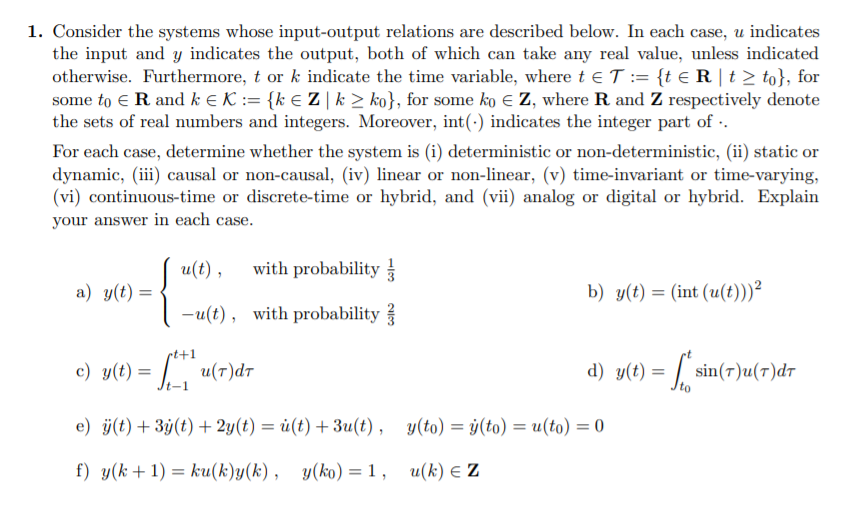Find the single-variable impulse-response function of each system described in Question 1, which is deterministic, linear, time-invariant, continuous-time, and analog. Assuming to = 0, find the transfer function of each system described in Question 1, which is deterministic, causal, linear, time-invariant, continuous-time, and analog. %3D
Find the single-variable impulse-response function of each system described in Question 1, which is deterministic, linear, time-invariant, continuous-time, and analog. Assuming to = 0, find the transfer function of each system described in Question 1, which is deterministic, causal, linear, time-invariant, continuous-time, and analog. %3D
Introductory Circuit Analysis (13th Edition)
13th Edition
ISBN:9780133923605
Author:Robert L. Boylestad
Publisher:Robert L. Boylestad
Chapter1: Introduction
Section: Chapter Questions
Problem 1P: Visit your local library (at school or home) and describe the extent to which it provides literature...
Related questions
Question
Q about Control Systems. We are looking for only THIRD and FOURTH question's answer. 1st is already solved

Transcribed Image Text:1. Consider the systems whose input-output relations are described below. In each case, u indicates
the input and y indicates the output, both of which can take any real value, unless indicated
otherwise. Furthermore, t or k indicate the time variable, where t eT := {t €R |t > to}, for
some to e R and k E K := {k € Z | k > ko}, for some ko E Z, where R and Z respectively denote
the sets of real numbers and integers. Moreover, int(·) indicates the integer part of .
For each case, determine whether the system is (i) deterministic or non-deterministic, (ii) static or
dynamic, (iii) causal or non-causal, (iv) linear or non-linear, (v) time-invariant or time-varying,
(vi) continuous-time or discrete-time or hybrid, and (vii) analog or digital or hybrid. Explain
your answer in each case.
u(t), with probability
a) y(t) =
b) y(t) = (int (u(t)))²
-u(t), with probability
rt+1
c) y(t) = |, u(T)dr
d) y(t) = | sin(7)u(7)dr
e) ÿ(t) +3ÿ(t) + 2y(t) = ü(t) + 3u(t), y(to) = ý(to) = u(to) = 0
%3D
f) y(k+1) = ku(k)y(k), y(ko) =1, u(k) E Z

Transcribed Image Text:3. Find the single-variable impulse-response function of each system described in Question 1, which
is deterministic, linear, time-invariant, continuous-time, and analog.
4. Assuming to = 0, find the transfer function of each system described in Question 1, which is
deterministic, causal, linear, time-invariant, continuous-time, and analog.
Expert Solution
This question has been solved!
Explore an expertly crafted, step-by-step solution for a thorough understanding of key concepts.
Step by step
Solved in 3 steps with 1 images

Knowledge Booster
Learn more about
Need a deep-dive on the concept behind this application? Look no further. Learn more about this topic, electrical-engineering and related others by exploring similar questions and additional content below.Recommended textbooks for you

Introductory Circuit Analysis (13th Edition)
Electrical Engineering
ISBN:
9780133923605
Author:
Robert L. Boylestad
Publisher:
PEARSON

Delmar's Standard Textbook Of Electricity
Electrical Engineering
ISBN:
9781337900348
Author:
Stephen L. Herman
Publisher:
Cengage Learning

Programmable Logic Controllers
Electrical Engineering
ISBN:
9780073373843
Author:
Frank D. Petruzella
Publisher:
McGraw-Hill Education

Introductory Circuit Analysis (13th Edition)
Electrical Engineering
ISBN:
9780133923605
Author:
Robert L. Boylestad
Publisher:
PEARSON

Delmar's Standard Textbook Of Electricity
Electrical Engineering
ISBN:
9781337900348
Author:
Stephen L. Herman
Publisher:
Cengage Learning

Programmable Logic Controllers
Electrical Engineering
ISBN:
9780073373843
Author:
Frank D. Petruzella
Publisher:
McGraw-Hill Education

Fundamentals of Electric Circuits
Electrical Engineering
ISBN:
9780078028229
Author:
Charles K Alexander, Matthew Sadiku
Publisher:
McGraw-Hill Education

Electric Circuits. (11th Edition)
Electrical Engineering
ISBN:
9780134746968
Author:
James W. Nilsson, Susan Riedel
Publisher:
PEARSON

Engineering Electromagnetics
Electrical Engineering
ISBN:
9780078028151
Author:
Hayt, William H. (william Hart), Jr, BUCK, John A.
Publisher:
Mcgraw-hill Education,